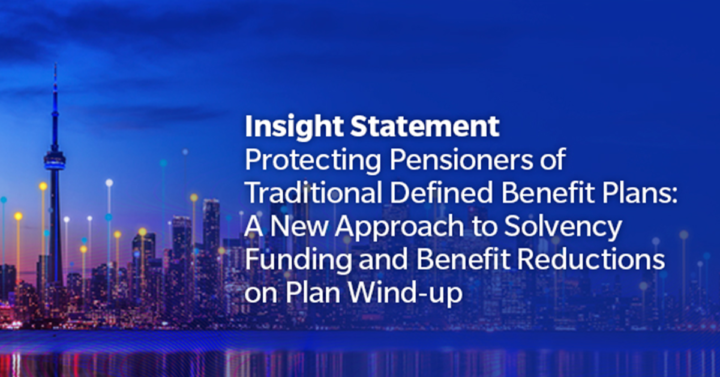
By Serge Charbonneau, FCIA, and Joseph Nunes, FCIA
In Canada, pension promises made to employees by employers are not guaranteed by insurance contracts. Rather, they are secured by requiring that the employer set aside assets in a pension fund independent of the employer, which delivers future pension promises should the employer lose the ability to support the pensions with enterprise assets.
Where the current system falls short, however, is when an employer goes out of business and a pension plan becomes wound up. Scenarios like this often run the risk that the assets set aside to deliver the promised pensions may not be sufficient, resulting in negative consequences for plan members, especially retirees who are without the means to replace lost retirement income from other sources.
The question begs: Is there is a better approach to addressing underfunded pension plans? We explore some potential answers in our paper Protecting Pensioners of Traditional Defined Benefit Plans: A New Approach to Solvency Funding and Benefit Reductions on Plan Wind-up, newly released as part of the CIA insight statement series.
Rethinking how we protect pensions
The current system for winding up underfunded defined benefit (DB) pension plans divides the segregated pension fund among all plan beneficiaries on a pro-rata basis according to the value of their pension entitlement. This means that if the available funds represent, for example, only 90% of the value of the collective promises, then each beneficiary sees a 10% reduction in their pension. This approach can leave older workers and retirees vulnerable.
Recognizing that older workers and retirees tolerate less risk, as there is less time and fewer options to remedy the negative impact of lost pensions, we suggest a new approach: rethinking the allocation of investment risk to members of DB plans.
Our proposal operates on the premise that retiree pensions would be better protected if the approach to solvency funding and benefit reduction rules acknowledged that younger workers tolerate greater risk and have more opportunities to recover from pension losses.
To this end, we suggest that governments consider the following changes to help protect older workers and retirees:
- Change solvency funding rules to target different solvency ratios for different categories of members and to determine different “tolerable” cutback levels in case of plan wind-up.
- Implement new risk sharing measures to reflect different risk levels tailored to different age groups.
- Allow entities to continue administering assets and benefits for any interested member who is retired or eligible to retire on plan wind-up.
- Implement a pensioners guarantee fund in all jurisdictions to limit cutbacks to prescribed “tolerable” levels.
- Allow interested members to make optional contributions or transfers from another vehicle to restore any portion of their benefit cutback on plan wind-up.
Recognizing that all plan members do not have the same appetite for the risks taken by the plan could lead to risk management measures that attribute experience gains and losses differently to different subgroups of plan members. What this means is that a plan could differentiate the risk levels desired on behalf of retirees in a certain age group versus active workers in a certain age group and determine different funded ratios for each group based on the experience gains attributed in reference to those desired risk levels.
Although there is no “silver bullet” that can solve all problems in the case of underfunded DB plans at wind-up, adopting some or all these changes could help to better protect older workers and retirees approaching and living in retirement.
Discussion questions
We would like to hear your comments and generate discussion that could help improve this proposal. Below is a list of possible aspects to address, although we invite you to focus on the ones that interest you most. Please note that all questions are intended for single-employer DB plans in the private sector.
- Do you think the paper’s proposals offer a realistic approach to dealing with solvency funding and benefit reductions on plan wind-ups?
- Is the proposal to increase solvency funding targets for older workers and retirees, while reducing them for younger workers, an improvement over the status quo?
- Is the proposal to tie benefit reductions to solvency funding targets (which vary by age) an attractive approach?
- What obstacles would you expect in implementing the proposed measures?
- What parts of the proposal are most appealing to you?
- What parts of the proposal would you reject?
- What alternative approaches would you suggest be considered?
- Do you think plan demographics should be a factor considered by the administrator in determining the level of risk included in its investment policy? Do you think many plans determine their level of investment risks based on their membership demographics? Do you think that when assets are commingled, then all members should share equally the gains and losses resulting from the overall plan risks? Do you think that attributing gains or losses differently to different member sub-groups on a notional basis is desirable or feasible?
- Do you agree that older members and retirees have less tolerance for a potential benefit cutback? Do you think this factor should be considered in determining how to allocate a plan’s wind-up deficit and cutback benefits? Do you agree that a member’s expected remaining lifetime is an indicator of their opportunities for taking future risks in the hope of making up cutbacks?
- Do you think that when members take risks individually after plan wind-up in the hope of making gains and offsetting their benefit cutbacks that they deserve to be the sole beneficiary of those gains because they also take an equal risk of suffering losses?
- Do you think it would be beneficial for retirees to participate in a run-out scheme that takes moderate risks for a few years before purchasing insured annuities? Do you think retirees who participate in a run-out scheme should be protected against potential losses from moderate risks by a guarantee fund, based on the proposed level of tolerable cutbacks? Or would you prefer a protection at a different level (e.g., 100% or some percentage of the tolerable cutbacks)? Do you think a run-out scheme should include the proposed group (i.e., members already retired or who choose to retire upon plan wind-up) and on an optional basis, or what would you prefer? Do you think the run-out scheme should attribute risks differently among its sub-groups? Do you think a run-out scheme should be administered by a government entity, by a plan administrator having fiduciary responsibilities, or by private commercial entities?
- Do you think members should be allowed to fund their own cutbacks with optional transfers from their individual registered accounts? Or in some different manner that you could suggest?
- Do you have any comments about other alternatives that are mentioned in the paper and about the reasons presented in the paper for not recommending them?
- Do you think some of the proposed measures could be appropriate for some types of plans other than those mentioned (i.e., single-employer DB plans in the private sector)?
Comment below to share your thoughts and keep the conversation going.
This article reflects the opinion of the author and does not represent an official statement of the CIA.






All comments below are personal only:
-An Excellent Paper! Well done!
-Glad to see that the CIA is expressing concern with unfunded private pension benefits, particularly since the Actuary is supposed to act in the public interest. In this sense, the process of recognizing that a problem exists and proposing possible solutions is most welcome. This should be the start of this conversation, and I would suggest that the conversation shouldn’t end until the Standards of Practice reflect some clear alternatives for the actuary to consider in the event of a funding shortfall. An evenly applied x% cut to all pensions should not be the only possible solution.
-expected average remaining service lifetime (EARSL) is a good measure of risk tolerance in a pension plan. It makes sense that retirees (or near retirees) have a lot less tolerance for risk than younger plan members, and this could be reflected in the distribution of benefit reductions in the event of a plan wind-up.
-allowing plan members to fund the pension shortfall with other retirement funds appears to be a reasonable option to offer in this situation. This option may allow the employee to smooth out pension income over his/her retirement years in a more tax-efficient manner. The cost to the plan is only a bit more upfront administration, but otherwise should be minimal.
-even in the event of a private pension plan wind-up and a benefit reduction, allowing plan members to continue to invest as a group may create a greater opportunity for the members to financially recover over the long-term.
Thanks Danny for those comments!
Glad to see you believe that actuaries can and should get involved to improve current rules for the good of the public.
Your suggestion of referring to EARSL is similar to ours, but I believe that members with an ERSL of zero (but still having a “significant” expected lifetime) could take on some small risk. I believe that even a 70-year old could accept a small cut (especially when seeing young ones get hit much harder) and then using a run-out scheme can help make it up somewhat.
Not sure how you would apply the EARSL approach, but if it creates even bigger differences, then it might be hard to implement.